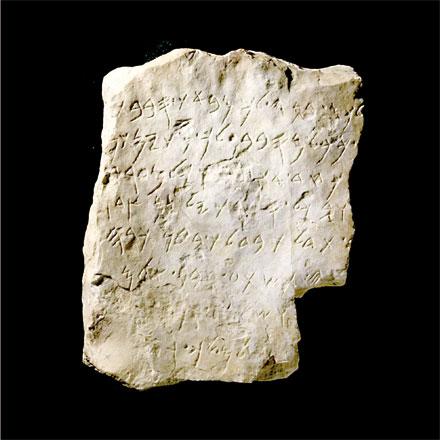You are here
Iron Age Ammonite statue says a lot about religion, influence by Egyptians, Assyrians
By Saeb Rawashdeh - May 08,2019 - Last updated at May 08,2019

AMMAN — A rescue excavation by the Department of Antiquities (DoA) of Jordan has uncovered a basalt statue in the forum area near the Roman Theatre in the downtown of Amman, described by an expert as “a unique and important archaeological discovery”.
The basalt statue dates from the Iron Age (circa 1,150-550 BC). Professor Joel S. Burnett from Baylor University in Waco, Texas said that it is a major archaeological find in the region, adding that it is “the only one of its kind discovered east or west of the Jordan River”. The closest comparison for the statue can be found in northern Syria and Iraq, dating from the Assyrian kingdom, he said.
The statue depicts an Amonite king, most likely dating to the 9th or 8th century BC, the scholar continued.
“Many centuries after the time of the Ammonites, this proud statue of a once mighty ruler apparently came to be regarded as just a large piece of debris from the distant past,” he said, adding that it was conveniently buried in the earthen fill used to complete the “forum” in around 200AD.
Although the statue was preserved in a secondary archaeological context, its form, style and motifs show that it belongs with other stone statues discovered in and near Amman, the researcher noted. He pointed out that these elements tell us much about the Ammonites’ religious beliefs and cultural connections with the broader ancient Near Eastern world.
That name is attached to what is still the most fully preserved and well-known Ammonite stone statue, the professor said, adding that it was one of four stone sculptures unearthed on the northern end of the Amman Citadel (Jabal Al Qala) in early 1950.
“Since the inscription on the base of the statue includes an extensive lineage for Yarh-Azar [partially reconstructed to read ‘Yarh-Azar’-son of Zakar, son of Shanib], he was certainly a member of the Ammonite royal family,” he explained.
“His grandfather Shanib may well be the Ammonite king Shanipu named in an Assyrian inscription around 734-733 BC, an identification made by the Jordanian archaeologist Fawzi Zayadine in the early 1970s,” Burnett underlined.
Thus, Yarh-Azar was a royal figure who likely lived around 700 BC, he underlined. “My own analysis of the statue’s artistic motifs — the elaborate clothing and, most importantly, the headband-type diadem and lotus flower — confirm that the Yarh-Azar statue portrays an Ammonite king, making him one of seven or eight named in Ammonite and Assyrian inscriptions.”
“Like the Yarh-Azar statue, it holds in its left hand the lotus flower, an emblem of Egyptian origin. The lotus motif reflects Iron Age Jordan’s long-standing cultural connections with Egypt and, more specifically, the Ammonites’ economic, political and cultural ties to the Phoenician coast,” Burnett explained
The tilting of the flower away from the face in the Ammonite statues belongs specifically to the “drooping lotus” motif, an emblem indicating a deceased ruler in the art of broader Syria-Palestine by around 1,000 BC, according to the expert.
However, the colossal scale of the Amman Theatre statue and the prevailing artistic style both of this statue and the other Amman statues point to the Ammonites’ long-standing cultural connections with northern Syria, even as “some clothing details, beard styles and lifelike body shaping reflect increasing Assyrian influence beginning in the 9th century BC.
“Like that north Syrian statuary, the Amman basalt statue and smaller statues belonged to a mortuary observance, a religious system honouring [in this case] deceased Ammonite rulers,” the scholar emphasised.
According to Burnett, these motives are part of an international symbol system that these statues reflect, even as they embody a distinctly Ammonite identity.
“More than 30 ancient stone statues, heads and busts discovered in Amman and its near vicinity derive from the Iron Age, when the city was the capital of the Ammonite kingdom,” he elaborated. “So far, such an extensive corpus of stone statuary is unique to the Ammonites among the contemporary kingdoms of the southern Levant.”
These sculptures show a distinctive style and combination of motifs, the researcher stated. Some of those motifs derive ultimately from Egyptian art traditions, most significantly, the Egyptian water lily, “usually referred to as the lotus, and the atef-crown, originally in the form of a conic hat with large feathers flanking the sides”.
Under Egypt’s long-standing political, economic and cultural influence, both of these motifs made their way into the art of Syria and Palestine by the late second millennium BC, Burnett maintained.
“A renewed prominence of such Egyptianising motifs in art across Syria-Palestine began during the 10th and 9th centuries BC, with a rejuvenation of Egyptian trade through Byblos,” the expert underscored.
He noted that these Egyptianising elements blended with artistic traditions, forms and motifs from northern Syria and Mesopotamia “in an international artistic koiné, a kind of shared symbol system of prestige and power that affirmed the exclusive status of royals and other elites across the Near East”.
Related Articles
AMMAN — The site of Jamaan is located in the Zarqa Governorate, approximately 16 kilometres north of Amman.
AMMAN — Amman and its surroundings were a main centre of the Ammonite Kingdom and some of their structures can be found on the Amman Citadel
AMMAN — The Ammonites were a Semitic ethnic group that controlled Amman and its surrounding areas during the Iron Age.


















